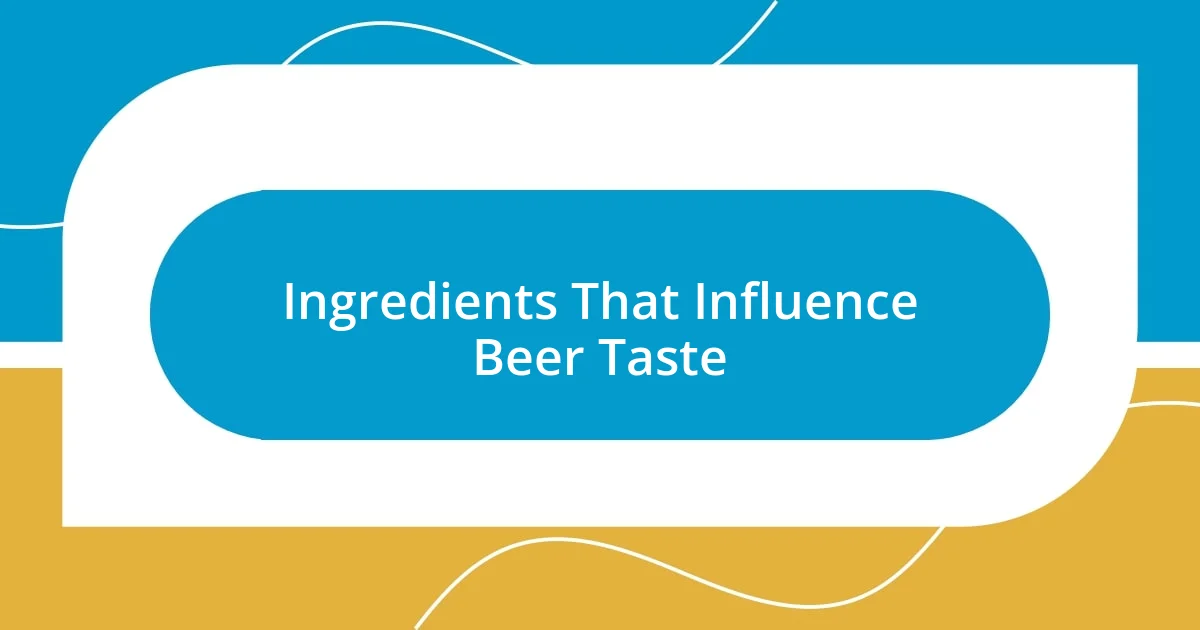Key takeaways:
- Understanding beer ratings is subjective, influenced by personal experiences and tastes, creating a unique tasting journey for each individual.
- Ingredients like malt, hops, and yeast significantly affect beer flavor and evoke personal memories, transforming tasting into a richer experience.
- The context of enjoying a beer—such as setting and company—can greatly impact the perception and rating, making the experience more meaningful.

Understanding Beer Rating Systems
When I first started exploring beer, I was overwhelmed by the variety of rating systems out there. From 1 to 5 stars to complex scoring based on aroma, taste, and aftertaste, it felt like learning a new language. Have you ever found yourself puzzled over what makes a beer a five versus a three? For me, the journey of understanding these systems has been about honing my palate and finding what features resonate with my taste.
Some rating systems break down beers into specific categories like bitterness or body, which can be eye-opening. I remember tasting an IPA for the first time and trying to decode its bitterness, measured in International Bitterness Units (IBUs). It was fascinating to realize how that number impacts my experience. Have you ever sipped a beer that claimed to have high IBUs but felt surprisingly smooth?
What I love about beer rating is that it’s highly subjective; what they say about tasting notes can really evoke different memories or feelings. I once rated a stout purely based on its nostalgic flavors that reminded me of homemade chocolate cake. Isn’t it interesting how our past experiences and personal preferences shape our understanding of each brew? Embracing that fluidity is what makes beer tasting so enjoyable and unique for everyone.

Ingredients That Influence Beer Taste
The taste of beer is deeply influenced by its ingredients, each contributing unique flavors that come together in a harmonious—or sometimes surprising—way. I’ve often found that the type of malt used can completely transform my experience. When I first tried a caramel malt beer, the rich, sweet notes brought back memories of caramel popcorn at the fair. It made me realize how crucial malts are in shaping not just the flavor but also the nostalgia attached to each sip.
Here are some key ingredients that influence beer taste:
- Malt: Varieties like pale, caramel, and roasted malts add sweetness, body, and color.
- Hops: Different hop varieties bring bitterness, aroma, and flavors like citrus, pine, or floral notes.
- Yeast: The fermentation process imparts flavors; for example, Belgian yeast can create fruity and spicy notes.
- Water: The mineral content and pH affect overall taste; soft water is great for stouts, while hard water benefits pale ales.
- Additives: Ingredients like fruit, spices, or coffee can enhance or completely change the profile, adding a personal twist.
I remember sipping a Belgian Witbier for the first time; the coriander and orange peel made it feel like summer in a glass. It’s fascinating how these ingredients can evoke such vivid memories or moments, turning mere tasting into a richer experience. Each ingredient contributes its own story, merging with others to create the tapestry that is the beer in my hand.

Assessing Beer Appearance And Color
Assessing beer appearance and color is one of my favorite parts of the tasting experience. When I pour a beer into a glass, I always take a moment to admire its hue. Whether it’s a golden lager that sparkles in the light or a deep, rich stout that invites you in, the color sets the stage for the flavors to come. I remember a particularly vibrant amber brew that caught my eye during a craft beer festival—it instantly drew me in, and of course, I had to taste it. That beautiful visual impression really heightened my anticipation.
In the world of beer, color can indicate a lot about what’s in the bottle. Lighter beers, like pilsners or wheat ales, often boast a crisp and refreshing profile, while darker varieties, such as porters and stouts, suggest a richer complexity. I once had a chocolate stout that was so dark it seemed almost opaque. The moment I took a sip, the deep flavors of roasted malt enveloped my senses, matching the beer’s bold appearance. It’s fascinating how just a glance can tell you about the brewing process, like whether caramel malts were used to deepen that color and flavor.
Here’s a neat comparison of beer colors and their typical characteristics:
| Color | Common Styles | Flavor Notes |
|---|---|---|
| Light Gold | Pilsner, Kölsch | Crisp, Clean |
| Amber | Pale Ale, Amber Ale | Caramel, Biscuit |
| Dark Brown | Porter, Dark Ale | Chocolate, Coffee |
| Black | Stout, Imperial Stout | Roasty, Rich |
These visual cues not only enhance our drinking experience but also create a conversation starter among beer enthusiasts. The next time you’re savoring a beer, take a moment to appreciate not just the aroma and taste, but also the beautiful canvas that introduces you to what’s to come!

Evaluating Flavor Profiles Of Beer
Evaluating flavor profiles is one of the most exciting parts of my beer journey. Each sip tells a story, woven through the sensory experience that unfolds on my palate. I still vividly remember tasting an IPa that burst with grapefruit notes; it was as if a citrus grove had exploded in my mouth. I often wonder how these flavors linger on, changing and evolving as I savor the beer.
When I explore different flavor profiles, I try to identify the key notes: Is it hoppy and aromatic, or does it embrace a malty sweetness? I once had a Berliner Weisse that was tart and refreshing, nearly dancing on my tongue. I couldn’t help but smile—it perfectly complemented a hot summer day. It made me realize how the right balance can transform a simple drink into an experience that not only quenches thirst but also uplifts the spirit.
I find it fascinating how the interplay of ingredients creates a complex flavor landscape. For instance, when tasting a stout, I always look for the layers of chocolate and coffee intertwined with hints of vanilla. I recall a local brew that had a surprisingly robust flavor, blending dark chocolate and roasted nuts; it was an unexpected delight! Each time I engage with a new beer, I ask myself: What sensations does it evoke? It’s this exploration that turns beer tasting into a personal adventure, one that I continually cherish.

Rating The Aftertaste Of Beer
When it comes to rating the aftertaste of beer, I often find it to be a moment of reflection. The finish can linger on my palate, sometimes offering delightful surprises. I remember sipping a barrel-aged bourbon stout, and as it went down, the warm notes of oak and caramel wrapped around my tongue. It was as if the beer wasn’t done speaking just yet; that lingering aftertaste held onto the experience long after the sip.
I’ve learned that the aftertaste can reveal much about the brewing process. For instance, a crisp lager might leave a clean, refreshing finish, while a hoppier IPA can sometimes impart a resinous bitterness that sticks with you. I had a double IPA once that shocked me—it was intense at first, but the way the bitterness evolved into subtle fruity notes was nothing short of mesmerizing. I found myself pondering: Is this aftertaste something I’d seek again, or has it overstayed its welcome?
Engaging with the aftertaste allows for a deeper appreciation of the craftsmanship behind the brew. I often think about how my perception changes based on mood and setting. I recall enjoying a rich imperial stout on a cold winter’s night; the warmth from the alcohol and the rich chocolate notes created a sense of comfort. Contrast that with a sunny afternoon sipping a spritzy sour, and it becomes clear how situational context shapes our experiences. How has the aftertaste of your favorite beer surprised you? For me, it’s always a moment to savor and contemplate.

Final Thoughts On Beer Ratings
When it comes to beer ratings, I find that they’re not just about scores or numbers—they are a reflection of my unique experiences. For instance, I once rated a hazy IPA while watching the sunset, and the soft orange hues seemed to mirror the beer’s vibrant flavors. That moment made me realize how our surroundings can enhance or even alter our perception of taste.
I also believe that the emotional connection to a beer can significantly influence how I rate it. I vividly remember sharing a rich stout with friends during our annual fall get-together. The warm camaraderie combined with the deep, chocolatey flavors made that beer unforgettable. I often wonder: Would I have rated it the same way if I’d enjoyed it in silence? My answer is likely no; context matters deeply in the world of beer.
Ultimately, I view beer ratings as a personal narrative, intertwining memories with flavors. Each beer tells a story that resonates differently with everyone. The next time you take a sip, I invite you to consider not just the taste, but also the memories it evokes and the moments it creates. Isn’t that what truly elevates a beer experience?














